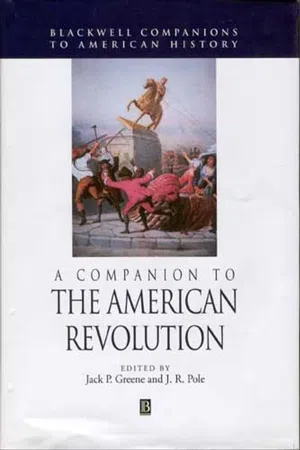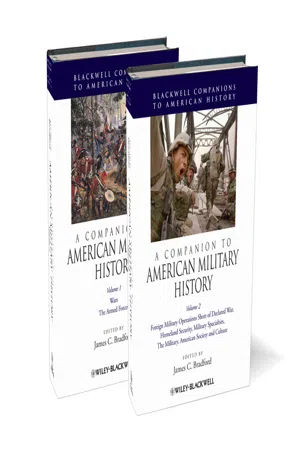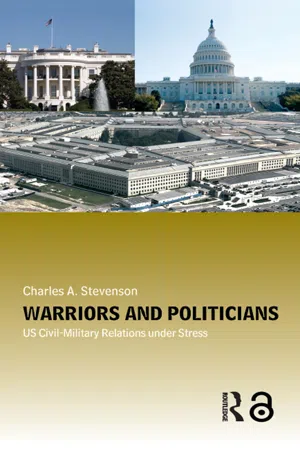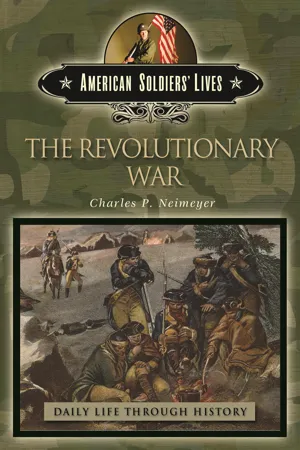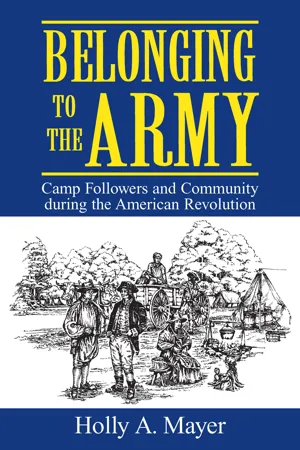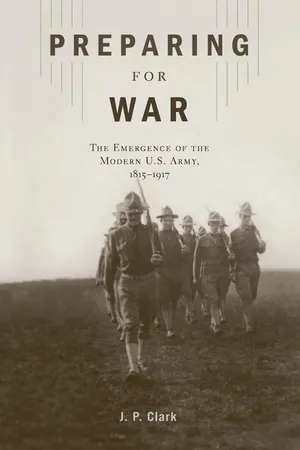History
The Continental Army
The Continental Army was the unified military force of the thirteen American colonies during the American Revolutionary War. Established in 1775, it was led by General George Washington and played a crucial role in securing American independence from British rule. The army faced numerous challenges, including lack of resources and training, but ultimately emerged victorious in the war.
Written by Perlego with AI-assistance
Related key terms
1 of 5
9 Key excerpts on "The Continental Army"
- eBook - PDF
- Robbie MacNiven, Adam Hook(Authors)
- 2021(Publication Date)
- Osprey Publishing(Publisher)
25 familiarize themselves with the North American wilderness. They also emphasized marksmanship, to such a degree that their competence was used to put on displays that encouraged support from Native American nations. All told, the diverse forces supporting the British crown on the frontier were either threatening or in control of vast swaths of land by early 1782, a state of affairs in sharp contrast to British failures on the Eastern Seaboard. The Continental Army The Continental Army was formed on the orders of the Second Continental Congress on June 14, 1775. Its creation met two major requirements: the need to create a regular army from the once-disparate colonies that could engage British forces throughout North America; and the desire to provide a greater degree of legitimacy to the concept of a new, single American nation with its own – albeit limited – standing military. From its inception, General George Washington was The Continental Army’s commander-in-chief. A popular member of the colonial gentry and a veteran of the Seven Years’ War, Washington led and championed The Continental Army throughout the conflict, at times in the face of fierce opposition from factions in Congress. The initial idea of a standing military was hotly debated by the revolution’s governing body, with a number of Guerrilla-warfare tactics were utilized by both sides during the war, especially on the frontier, where mixed forces of British-allied Native Americans, Loyalist volunteers, Provincials, and small groups of British regulars proved particularly effective. (ivan-96/Getty Images) 26 limitations placed on it during the early stages of the war – citizens enlisted for just a year at a time, and The Continental Army was forbidden from exceeding a strength of 17,000 men. As the war progressed and its scale became apparent, however, a number of reforms drastically altered the new military force’s size and remit. - eBook - PDF
- Jack P. Greene, J. R. Pole, Jack P. Greene, J. R. Pole(Authors)
- 2008(Publication Date)
- Wiley-Blackwell(Publisher)
Besides proposing to raise ten companies of riflemen to come from Pennsylvania, Maryland, and Virginia, the delegates adopted the New England troops encamped around Boston, the other New England provincial forces that had mustered for ser-vice elsewhere, and the New York units being formed to defend strategic positions in that province. They also appointed a committee to draft the rules and regulations that were to govern the army. When they met again the next day, they chose the Virginian George Washington to be the new army’s Commander-in-Chief. Their decision was based on political as well as military concerns: they not only needed someone militarily qualified for the position but a person from outside New England, for they had to show that there would be continental participation and support in military as well as political endeavors. The decisions of the delegates to Congress on those two days and over the course of the eight long years following – until the war was won and the Confederation Congress dismissed some and incorporated other continental units within the United States Army in 1783 – along with those of offi-cers, soldiers, and observers reveal that The Continental Army had two roles: the primary one was to execute the war; the secondary one was to represent the Confed-eration and the American people. 1 Execution The Continental Army’s principal mission was to apply force to defend the people, property, and liberty of the united colonies. Once Independence was declared, the army’s mission expanded. It had to exercise the will and power behind the words, for it had to execute the separation from Great Britain and thus ensure the success of the Revolution. Washington reminded both his troops and the civil authorities of this time and time again during the war. - Major Douglas D. Jones(Author)
- 2014(Publication Date)
- Golden Springs Publishing(Publisher)
Before discussing The Continental Army, it is necessary to clarify the ambiguity of the term and to understand what is meant when the term is used. Three categories of soldiers fought during the American Revolution. The Continental Army was comprised of soldiers who had enlisted for a lengthy term of service (possibly the duration of the war), who received payment from the Continental Congress and served in a unit clearly defined by Congress as a Continental unit. The second category of the American soldier was the militia. Also an ambiguous term, by law the militia was comprised of soldiers that were called into service, as required, by their colonial (after 4 July 1776 their state) government for short periods. The majority of the times, the members of these militia units were at home pursuing everyday civilian activities. At various times, states also needed soldiers for longer periods of time than authorized by the rules of the militia. When this occurred, states formed units for a stated number of months for a specific purpose such as guarding the state’s frontier. These were called state regiments. Often these soldiers were drafted from the militia, with each militia regiment required to furnish a specific number of soldiers. Adding to the ambiguity of terms, a state could place a militia unit in Continental service. Because each state had its own techniques and requirements of raising militia, it is impossible to distinguish between the two.For the purpose of clarity, only two categories of soldiers will be discussed, The Continental Army and the militia. These two categories fit well with the opinion of the Continental officers of the revolution who considered any unit that was not a Continental regiment to be a militia unit.{106} The category of militia will be discussed in more detail following the discussions of how The Continental Army limited Washington’s ability to implement his strategy.In the late 1700s armies were relatively small. Commanders carefully trained and painstakingly disciplined their soldiers. It took two years of training to turn a man into a soldier. Generals preferred to engage enemies on open and flat terrain. These favorable conditions made it easy for commanders to synchronize their tight, linear formations to achieve success. During this period, commanders could maneuver well-disciplined troops in a methodical manner. The reliance commanders had on these techniques made battle in forested terrain, attacks at night, and winter campaigns full of unwanted risks. Washington adhered to these norms. He relied on Humphrey Bland’s Treatise of Military Discipline, the classic British military manual of the day.{107}- eBook - PDF
- James C. Bradford, James C. Bradford(Authors)
- 2009(Publication Date)
- Wiley-Blackwell(Publisher)
The Continental Army 323 By the 1930s, interest in the Revolution shifted from those who fought on the American side to those who had opposed them. Thus began a more modern reexamination of the loyalist perspective. During the 1930s, scholarly and sympa- thetic works on the British high command and even the long reviled Hessians appeared on the market. All this historical activity enabled the loyalist oppositional point of view to be considered as legitimate for the very first time and made their activities less vilified than their prior treatment at the hands of the romantic and nationalist schools. Following the end of World War II and largely continuing to the present day, there has been a renewed interest in The Continental Army. Lynn Montross, Rag, Tag, and Bobtail (1952) and Joseph B. Mitchell Discipline and Bayonets (1967) tell the story of the army and men who served it to a popular audience. Robert K. Wright’s The Continental Army (1983) presents a more comprehensive and scholarly assessment of the service. The evolution of The Continental Army from a rather ineffective collection of individualists at New York in 1776 into an effec- tive fighting force three years later has been traced by John Buchanan (2004) and Thomas Fleming (2005), though a contemporary writer, Wayne Bodle (2004) challenges these works and the traditional view that Washington’s army was trans- formed during the winter at Valley Forge. Bodle argues that Frederich von Steuben and the drill he instituted at Valley Forge did not play a significant role in trans- forming the army and bringing it success in the future and asserts Washington overstated the gravity of supply problems to pressure Congress into providing better support for the army, thus implying a need to revise the assessment of E. Wayne Carp, To Starve the Army at Pleasure (1984), and the traditional view that the army’s supply system was totally inadequate. - eBook - ePub
Revolutionary Armies in the Modern Era
A Revisionist Approach
- S.P. Mackenzie(Author)
- 2013(Publication Date)
- Routledge(Publisher)
2 The Continental Army in the War of American Independence, 1775–82 Virtue in arms?Spirit and confidence … the best substitute for discipline.John Adams, October 17751When men are irritated, and the Passions inflamed, they fly hastily and cheerfully to Arms; but after the first emotions are over …George Washington, September 17762The War of Independence has always enjoyed enormous resonance within American society. It was, after all, the event which brought the United States into being on the basis of constitutional forms and principles which (it is claimed) are as relevant today as they were over 200 years ago. And in consequence, the patriotic myths surrounding the struggle for independence remain enormously potent.3From the first, those who supported the American Revolution portrayed the war in essentially moralistic terms. The virtuous colonists, united in their cause, had been forced to take up arms in defence of their natural liberties against a despotic monarch and his avaricious ministers who were attempting to subvert those rights. This was how the Continental Congress and colonial legislatures explained the course of events after Lexington and Concord, and — since the past is almost always written up first by the winners — also the terms in which the earliest histories of the War of Independence were written. Virtue had triumphed over vice.4The justness of the American cause, moreover, had been reflected in how each side had approached the military aspects of the conflict. The British had relied on a standing army — in and of itself a symbol of despotic tendencies — the ranks of which were composed of the dregs of society, men motivated only by the desire for pay and plunder and fear of the lash. Lord North had even hired foreign mercenaries, the dreaded Hessians, whose outlook and conduct was even more reprehensible. Such troops were liable to misbehave or desert if given the slightest opportunity, and therefore had to be kept under constant surveillance, forced to fight and manoeuvre en masse, in rigid linear formations unsuited to the terrain of the New World. As for the upper-class officers, they were the personification of aristocratic haughtiness: lazy, unwilling to think and adapt, and dismissive of people's rights.5 - eBook - ePub
Warriors and Politicians
US Civil-Military Relations under Stress
- Charles A. Stevenson(Author)
- 2006(Publication Date)
- Routledge(Publisher)
3 In fact, Washington was to be on duty and away from home for the next seven years, except for 10 days just before the climactic battle at Yorktown in 1781. Besides enemy forces and the privations of eighteenth century military encampments, Washington also had to contend with the Continental Congress, a body ill-suited to manage a life-or-death conflict. The Congress was a part-time group of lawyers, merchants, and farmers gathered from the 13 colonies to fashion a common response to British policies in North America. It had no power to raise money or armies, but was dependent on the voluntary responses of the various provincial legislatures to its requests. Prior to independence, foreign recognition, and the election of new state governments under new constitutions, it had questionable legitimacy. Twice it was forced to flee its home base of Philadelphia to escape capture by the British. Yet it wrote the rules and gave the guidance to Washington and his Continental army, and struggled to acquire the weapons and supplies that allowed it to survive and fight and ultimately win. In that long process of war and diplomacy, fund-raising and law-making, consideration of matters profound and mundane, the Continental Congress and Washington set precedents and practices which have endured into the twenty-first century. The civil-military relations during the Revolutionary War established the model, including tensions and flaws, for later conflicts.Decisions for war
It was by no means inevitable in June 1775 that the 13 colonies would declare their independence or be successful in achieving it. The First Continental Congress, meeting in the fall of 1774, declared its fealty to King George III and blamed parliament for “unjust, cruel, and oppressive acts” against the people of Massachusetts. The delegates called for a boycott of British goods and passed Articles of Association to monitor its implementation through local committees of correspondence. They hoped that redress could be achieved peacefully. When sending copies of its resolutions to Benjamin Franklin in London, the Secretary of the Congress, Charles Thomson, wrote, “Even yet the wound may be healed & peace and love restored: But we are on the brink of a precipice.”4By the time the Second Continental Congress assembled on May 10, 1775, however, blood had been shed at Lexington and Concord and an army of perhaps 18,000 New Englanders had gathered near Boston to fight the British force. The delegates authorized several preparations for war even as they named a committee to draw up a petition to the king for peace. On June 3, the congress set up a committee to consider ways and means of borrowing £6000 to buy gunpowder. On June 14 it called 10 companies of expert riflemen be raised in Pennsylvania, Maryland and Virginia and sent to Boston. The same day it appointed a committee to “draft rules and regulations for the government of the army.” On June 15 it voted to name George Washington “to command all the Continental forces.” And on June 16 it adopted a plan of organization for the army and established a committee to prepare instructions.5 - eBook - PDF
- Charles P. Neimeyer(Author)
- 2007(Publication Date)
- Greenwood(Publisher)
The loyalists could rarely muster similar forces that acted and openly drilled in the manner of the patriot militia even in the south where loyalist sentiment in the backcountry was thought to be especially high. The Congressionally mandated eighty-eight-battalion Continental army force never fully materialized for Washington. By late spring 1777, Washington had about "forty-three [understrength] regiments of about 200 men" each in central New Jersey. But on the bright side, secret supplies from the French were starting to arrive, to include twenty thousand new Charleville muskets, barrels of precious powder and flints, food, clothing, and blankets. However, for the coming campaign season, Washington would have far fewer than the twenty thousand effectives he had in 1776 to defend New York City, and the British, during this same time, had substantially increased the number of troops they had sent to North America. But the army Washington did have (about nine thousand men) were considered long-termed "regulars," and at least in his mind these men were probably worth more than double the same amount of short-termed militia who were, as he had earlier complained to Congress, in the field on one day and gone the next. 2 WOMEN AND THE ARMY There was one significant component of the army that has, until very recently, been neglected by historians, and that was the large number of women who followed and sup- ported army operations, even at times as regular musket-wielding or cannon-firing combat soldiers. During the eighteenth century, women were an integral and accepted part of regular army regimental establishments. This system was practiced by nearly all European armies of the time, and thus it was copied by The Continental Army as well. These "women of the army" were usually the wives of noncommissioned officers (NCOs) and were accorded an official "half-ration" for subsistence. The standard number on the roles of each company was usually around four or five. - eBook - PDF
Belonging to the Army
Camp Followers and Community during the American Revolution
- Holly A. Mayer(Author)
- 2023(Publication Date)
- University of South Carolina Press(Publisher)
52 Soldiers, generally being the young and less well-to-do, which was trans- lated by some contemporaries as the more irresponsible, irreverent, and indi- gent members of American society, were induced into its service but not always welcomed (in contrast to the more socially acceptable officers) into its commu- nities. Americans who wanted to believe that the army was a patriotic band of solid citizens did not like being confronted with what appeared to be mercenar- ies and an increasingly professional army. It suggested something about them- selves-namely, a diminution of virtue and equality-that they did not want to know. 53 So when the enemy had already disrupted local life, the army's pres- ence was accepted with relief; but when the army itself proved disruptive, when it created problems rather than peace and profits, then the civilian communities took no pleasure in its company. Washington and his commanders worked throughout the war to change that attitude by trying to create respectable sol- diers and an acceptable army. They sometimes had help from the civilian au- thorities. The Continental Congress and state governments occasionally acted as mediators in troublesome situations by passing resolutions that controlled local government and resident transactions with the soldiers. For example, in 1777 the General Assembly of Delaware passed a resolution stating that it was un- lawful to arrest a soldier in the American army for debt, unless the plaintiff swore before the proper witnesses that the soldier owed more than fifty dollars. It also declared that "no inn-keeper, tavern-keeper or public house-keeper, shall demand, take or receive from any recruit or soldier, whilst upon a march, any more than One-sixth of a Dollar for any one meal," nor could such persons demand or accept recompense for lodging these recruits or soldiers. - eBook - PDF
Preparing for War
The Emergence of the Modern U.S. Army, 1815–1917
- J. P. Clark(Author)
- 2017(Publication Date)
- Harvard University Press(Publisher)
A PROFESSION BORN IN WAR • 11 militia for national defense. This bolstered their political aim of keeping powers with the states. The Antifederalists were far less sanguine about the benefits of a standing army; they associated professional soldiers more with King George’s redcoats than with Washington’s Continentals. But many also drew quite different conclusions from the Revolution. There was a popular belief that the militia had won the war, a notion grounded in the conviction that men fighting as a matter of republican duty and patriotism were better soldiers than professionals fighting out of mercenary interests. Though a highly selective and quite flattering interpretation of the military record of the militia, that view was initially the ascendant. In 1783 and 1784, Con-gress debated whether it even had the authority to maintain a peacetime standing army. Thus, the initial military policy debate pitted a mythical militia against the aspiration of a professional force. 1 But while a few years of government under the Articles of Confederation created the conditions for pragmatic political compromise that eventually led to the Constitution, the discussion of military policy remained polarized, abstract, and ideological. The Federalists succeeded in creating a standing army and even won constitutional recognition of the federal government’s right to regulate the states’ militia to ensure some measure of uniformity. But the Antifederalists, fearing that this was a cynical ploy to weaken the militia, won the battle in practical terms; the 1792 Militia Act essentially abrogated federal oversight, leaving the states free to regulate or neglect their soldiery as they saw fit. This established the pattern that would endure until the twentieth century: In peace, the United States would maintain two distinct military systems, federal regulars and state militia, with virtually no coordi-nation or planning as to how they might be used in time of war.
Index pages curate the most relevant extracts from our library of academic textbooks. They’ve been created using an in-house natural language model (NLM), each adding context and meaning to key research topics.

